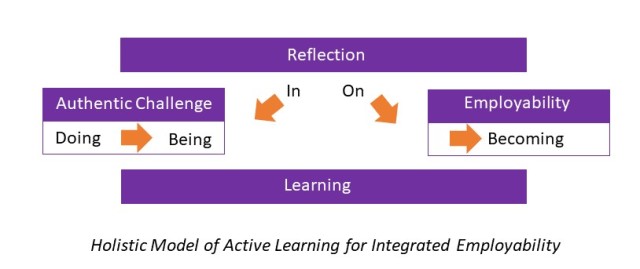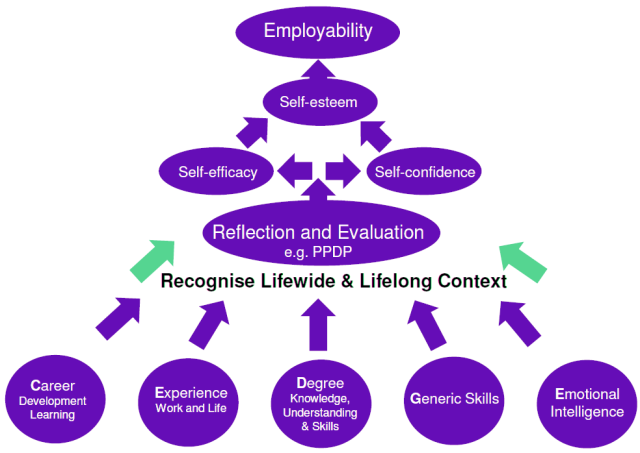You may be aware that I changed job this year and I now have the privilege of leading work in support of Anglia Ruskin University’s Active Curriculum Framework. It was the institutional commitment to active learning in its Education Strategy that attracted me – a very rare and clear ambition in my experience of UK higher education.
So, exciting times as I lead work on learning spaces, media-enhanced teaching and learning (METaL), and employability as an outcome of an integrated and active approach to teaching and learning.
Clearly, all these areas are intertwined, messy and contextually very complex! That about sums up why most universities shy away from being so explicit about developing active learning at scale. It is very difficult, but actually very achievable when there is the clarity set out already as at ARU.
In this post, I want to think through the interdependencies evident in the relationships between active and authentic learning, an integrated approach to developing graduate identity and employability, and the need to develop reflective learners as a prerequisite to learner engagement in the Active Curriculum. I find myself in situations where I assume people understand these interdependencies, and they don’t. Further, I am not sure how well I am articulating these, so forgive me while I try to present this with some clarity.
My thinking is captured in this first draft of a Holistic Model of Active Learning for Integrated Employability. I will go on to explain why I think this articulates what is needed.

Active Curriculum, reflection and employability in sync
I am very clear that pedagogically, active, authentic and applied learning create a stimulating and rewarding learning environment. To understand the basis of my confidence, think about the principles set out by Herrington through their many years of work, e.g. Herrington, Parker, & Boase-Jelinek, 2014; Herrington & Parker, 2013; Reeves., Herrington & Oliver, 2002; Herrington & Oliver, 2000; Jan Herrington’s useful website; and my own posts here.
Active learning’s ‘double whammy’
In brief, giving students things to do gives them two things to think about: the substantive problem in hand (‘the content’) and their own approach to addressing it (‘the self’). Perhaps the key argument for an Active Curriculum is that it should always deliver these outcomes in alignment – active learning’s ‘double whammy’.
However, ‘the self’ outcomes (self-awareness, self-esteem, self-actualisation – the pursuit of reaching one’s full potential) are products of reflection ‘in’ and ‘on’ experience, action or reaction. Learning about oneself by reflecting on the things you do may ‘just happen’, but a critical, systematic approach to engaging with challenging learning situations is a key part of active learning design; one that needs to be designed, developed, delivered and scaffolded through good teaching in the classroom or through good tutoring. Importantly, in terms of graduate outcomes and employability, becoming an effective reflective lifelong learner should be understood in terms of graduateness and it should be understood as one of the main benefits of a higher education. But it doesn’t ‘just happen’, it’s a skill that has to be practised until it becomes habitual.
When students are challenged to address an active learning situation or to undertake an authentic task, a situated learning environment is established (e.g. see Lave & Wenger, 1991; or John Seely Brown’s thinking, such as ‘Learning in a Digital Age’ or Brown et al., 1989). So far, so good. Hopefully, the learners’ curiosity is piqued and they become engaged in or committed to responding to the situation. Reflection in and on the experience should result in the student making observations and deductions, and from this, the learner should be supported in synthesising their experiences by forming abstract conclusions or conceptualisations which they can go on to apply to other situations in order to test them, and refer back to (applied learning), e.g. as examples of experience in a job interview or when addressing new and challenging situations in life. This is articulated in many explanations of reflective learning including Kolb’s experiential learning cycle (Kolb, 1984).
It is also reflected in the useful CareersEdge model (Dacre Pool & Sewell, 2007). In this reworked diagram of the model, I have indicated how the model can be enhanced by connecting it to ideas of lifewide and lifelong learning as valuable motivational contexts for the learner.

In conclusion…
Active learning strategies work when the pedagogic design incorporates a systematic approach to reflecting in and on the learning experience. It is designed holistically to incorporate disciplinary knowledge and self-knowledge. Reflecting ‘in’ learning uses and develops analytical skills. ‘Reflecting on’ learning is a metacognitive process leading to self-esteem and fulfilment through a learner’s systematic evaluation of their experience: ‘learning from experience’. Learning how to learn from experience is critical to optimising learning through the Active Curriculum, though it is a post hoc dimension of learning – the passing of time, finding objectivity, understanding its context and application, and using a reflective framework will all help the learner to assess their ability and their growth. A Personal & Professional Development Planning framework supported by good academic tutoring or advising is needed, as well as the learner’s own engagement in PPDP. These are necessary to develop and support a learner’s systematic reflection on learning and their ability to apply this skill through life.
Space for PPDP is needed, therefore. Possibly a type of space that does not yet exist for some students. That space needs to be designed in such a way that it accommodates each learner’s development as a reflective learner and their metacognitive appreciation of their own growth and sense of becoming. It may be found in the curriculum, in the co-curriculum, or through the independent use of PPDP portfolios or e-portfolios.
Active learning design without reflection may only achieve the learning of content knowledge, but even then its use may puzzle and even disengage students. Active learning with a holistic and integrated approach to reflection, on the other hand, builds self-efficacy, self-confidence and self-esteem which can lead to self-actualisation or a sense of fulfilment and, ultimately, employability.
References
http://www.uclan.ac.uk/information/uclan/employability/careeredge.php
development. Upper Saddle River, NJ: Prentice Hall.
